This photo is from a series Peter calls Noelanders trees. (Noelanders refers to the Noelanders Trophy Exhibit). He doesn't say what it is, but I'll guess that it's a Norway spruce (Picea abies) root-over-rock. You might notice the wavy drum pot.
A Bonsai in an Unusual Setting (& Others)

It's a little surprising that there are so few good shots of bonsai in creative settings. This one was borrowed from Peter Warren's Surayama, as were all the photos in this post.
Still catching up form vacation, so for expediency’s sake we’ll plunder our archives. This one is from June 2015. It was titled ‘Surayama – Shimpaku, Spruce & Several Others.‘
–
–

This Shimpaku juniper with its fluid deadwood and heavy crown is another from Peter's Noelanders trees. I'm guessing that the companion is a root-over-rock Trident maple.

This powerful tree with brilliant berries must be a Japanese winterberry (Ilex seratta). It's hard to tell what's going on with the companion. Like the previous two, this one is labeled Noelanders tree.

A closer look.

This one is a Rosemary. I'm not sure I've ever seen a pot quite like this one. I wonder where it came from
–
Magnificent Old Larch Bonsai, Before & After
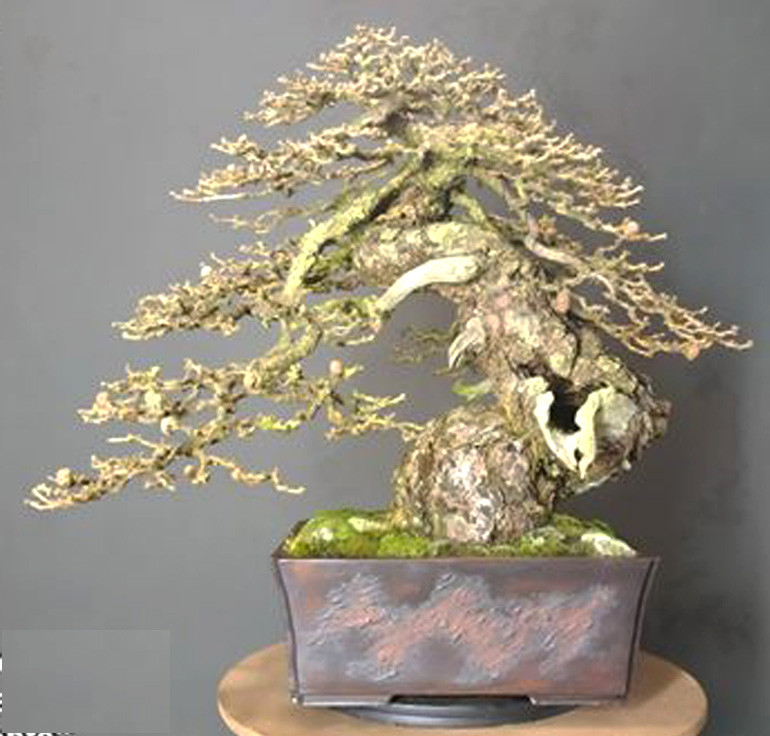
The Guardian of Laments is Giacomo Pappalardo's name for this magnificent old European larch (Larix decidua)
Another before and after and it’s a good one. I have a soft spot for larches, though ours are Tamaracks (Larix laricina) and this one is a European larch (Larix decidua). Not the same tree, but similar, though the similarity ends when you compare a tree like this with the much younger ones I’ve been growing here for the last fifteen years or so (this one was no doubt collected from the wild and shows all the signs of great age). Here’s your link to Giacomo Pappalardo timeline for more on this tree.
–
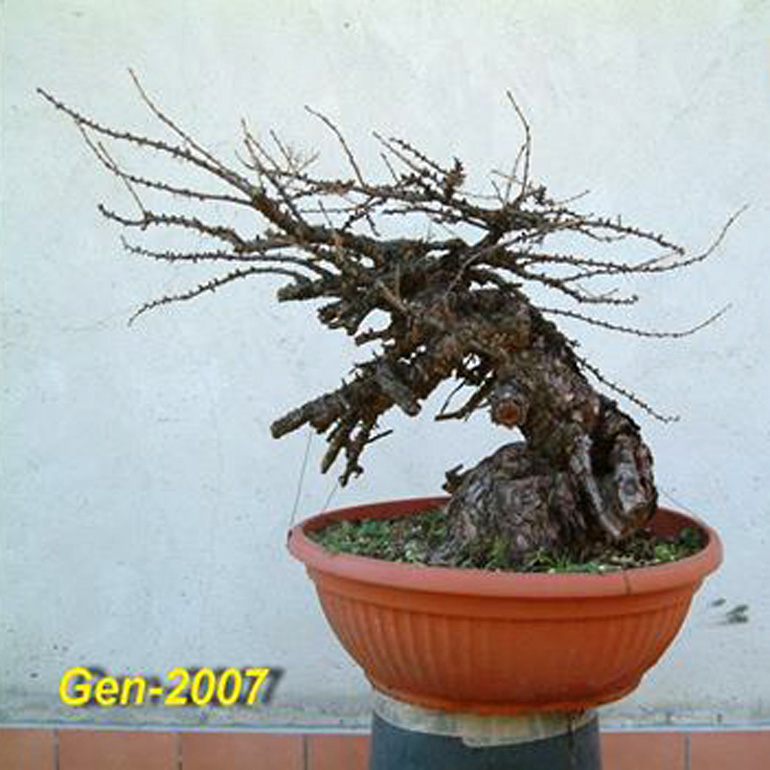
Before, from 2007. I don't know when it was collected

Lots of action in the old trunk...

...and a well developed apex makes for a impressive old tree

Here's Giacomo's before and after (after and before) photo
Sheer Bonsai Power – Before & After

We usually start Before and After posts with an appropriate B & A photo (see below). But I couldn't resist this one. I think it captures the essence of the tree. Or at least its size and sheer power
I found this impressive before and after pine on Luis Vallejo’s timeline. The only caption provided is… “Hiroaki Suzuki , Pinus sylvestris, Luis Vallejo Bonsái Garden.” We know Luis from numerous posts here on Bark and we also know a bit about Pinus sylvestris (Scots pine). I’m not familiar with Hiroaki Suzuki, but if you’d like to do a little research, here’s a link for you
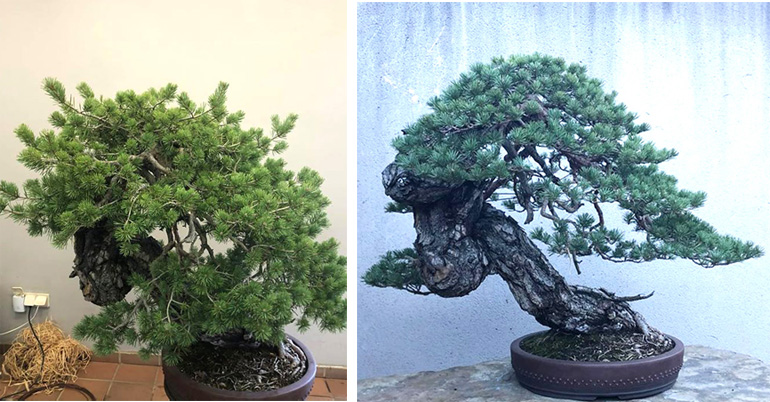
Before and after
ANNOUNCING the National
Bonsai & Penjing Museum’S NEW WEBSITE
Before we go on any further I’d like to announce that our good friends at the National Bonsai and Penjing Museum have a brand new website and it’s wonderful! With no intention to insult all the devoted people and the hard work they put into their previous sites, this one is a vast improvement. Expect more here soon. Meanwhile, go take a look for yourself
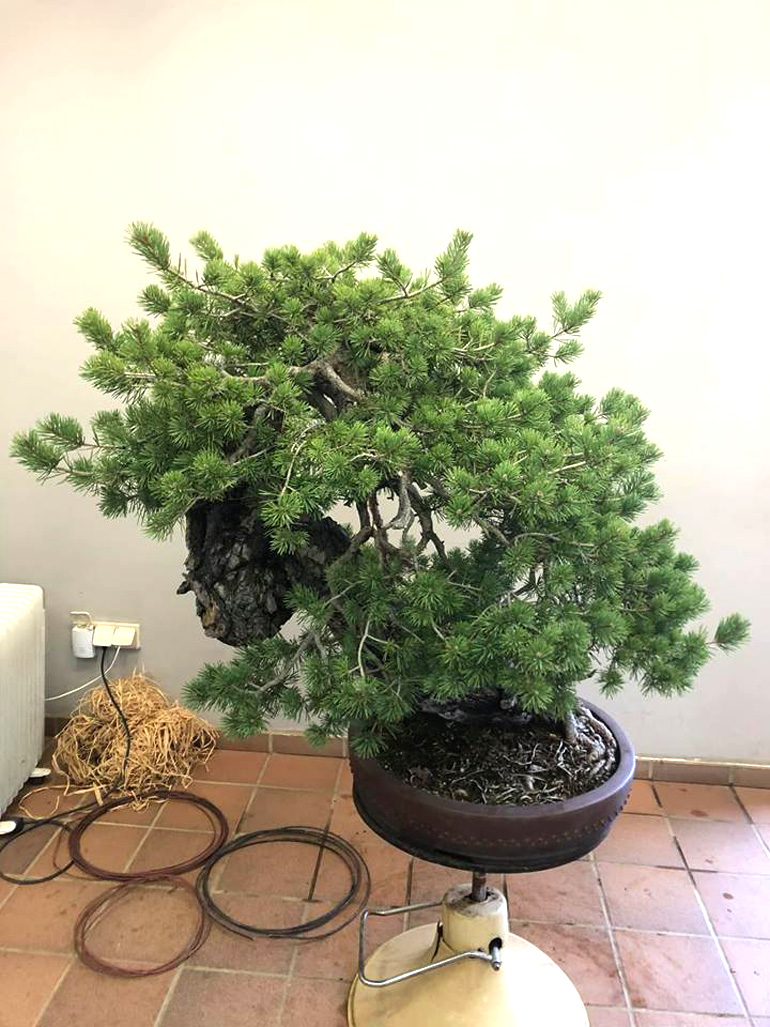
The original before photo

The original after photo

Artists at work
Omiya’s Pines, Bonsai Beauty & Heart

Combining two arts and two artists, here's a small piece of the translation with this striking photo... "Daiki Abe: Bonsai Artist. Takashi Eguchi: Photographer. Name: the two exhibition of bonsai and photography 'Pine Beauty heart'" There is no species given with this pine, but it looks like a Japanese white (Pinus parviflora). The photo is from Omiya Bonsai Museum's timeline, along with more information on the display. The rest of the photos in this post are Japanese white pines, also from Omiya's timeline, but not from this display
We could go on indefinitely with photos from the Omiya Bonsai Art Museum. However, we’ve got some other post waiting in the wings, so we’ll make this Japanese white pine feature the final in our Omiya series. For now at least
BRAND NEW SPECIALS
30% – 40% off Bonsai Aesthetics Tools
30% off Bonsai Books
25% off Bonsai Fertilizers
Hundreds of other Items Discounted
Extra 10% off Orders 150.00 or more
–
Here's a famous Japanese White Pine that we've shown at least twice here, though perhaps not with this scroll. In fact, it's so famous that it has its own name... Sokaku. I looked it up online and got several variations, but the one that makes the most sense is 'separation resulting from hostility'

I love the rugged simplicity of this tree. No variety is given, but it looks to me like a White pine

Multiple trunks sharing a single root system
SPEAKING OF PINES…

OUR MASTERS SERIES PINE BOOK
is now 30% off with our bonsai book sale
–

The round sun mirrors the round tree

More rugged simplicity and a strong nebari for a pine.
BRAND NEW SPECIALS
AT STONE LANTERN
30% – 40% OFF BONSAI AESTHETICS TOOLS
30% off 1 – 2 tools – 40% off 3 or more
–
30% OFF BONSAI BOOKS
25% OFF BONSAI FERTILIZERS
–
HUNDREDS OF OTHER ITEMS DISCOUNTED
EXTRA 10% OFF ORDERS 150.00 OR MORE
FREE Shipping on Continental U.S. orders 75.00+
(only if you chose free shipping when you check out)
STONELANTERN.COM
Omiya Bonsai Art Museum, this time with new photos

Japanese apricot (often referred to as Ume) at the Omiya Bonsai Art Museum in Saitama, Japan. You can see the whole tree below
We’re going to continue with the Omiya Bonsai Art Museum today, but this time with newly posted photos from their facebook timeline. Ones we’ve never shown before
20% OFF EVERYTHING
SITE WIDE SALE
ENDS TONIGHT
PLUS AN EXTRA 10% TO 20% OFF ROSHI TOOLS
AN EXTRA 10% OFF BONSAI POTS
THESE SPECIALS END WEDNESDAY, JAN 23RD AT 11:59PM EST
–

Star jasmine fully cascading with all the foliage below the pot

Another Japanese apricot (Ume). This time with a moon pot

Camellia japonica 'Unryu.' Is the pot made of bamboo or is it ceramic made to look like bamboo?

This elegantly flowing tree is a Camellia wabisuke 'Hatsukari'

Like so many Japanese maples in Japan, this one has an impressive nebari

Shadow dancing. The Japanese apricot from above
20% OFF EVERYTHING
SITE WIDE SALE
ENDS TONIGHT
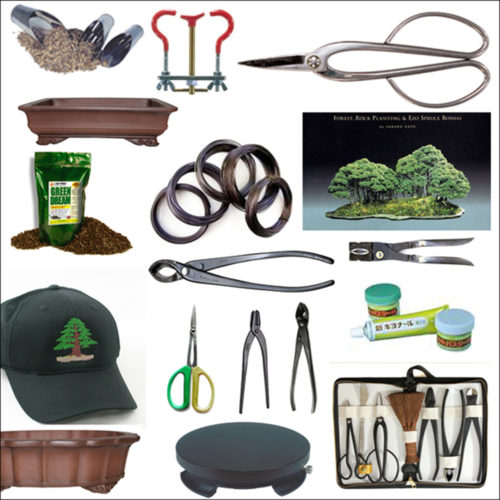
YOU CAN ENJOY EXTRA DISCOUNTS
IN ADDITION TO OUR SITE WIDE SALE
EXTRA 10% OFF 1-2 ROSHI TOOLS
20% OFF 3 OR MORE ROSHI TOOLS
PLUS AN EXTRA 10% OFF BONSAI POTS
–INCLUDING OUR TIE POTS–
THESE SPECIALS END WEDNESDAY, JAN 23RD AT 11:59PM EST
FREE Shipping on Continental U.S. orders 75.00+
(only if you chose free shipping when you check out)
STONELANTERN.COM
Masters of Refining Bonsai
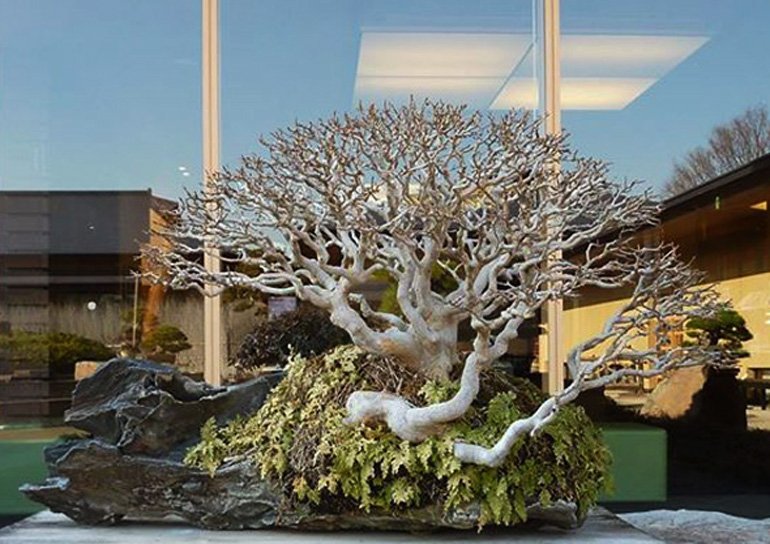
We don't usually feature photos with so much background noise, but this Trident maple is phenomenal and it's the only shot we've got
Just home from vacation. The return was supposed to be a two day trek, but snow added a day. Anyway, it’s late and I could skip today’s post, but instead we’ll just keep digging up Omiya Bonsai Museum photos from our archives (this one is from January, 2015). It’s easy enough and it will provide another opportunity for a heads up about the end of our Site Wide Sale tomorrow night
All the bonsai shown here resides at the Omiya Bonsai Art Museum in Saitama, Japan. They all deciduous trees in winter with their bare bones exposed. A good time to study line and ramification
Continued below…
20% OFF EVERYTHING
SITE WIDE SALE
ENDS TOMORROW NIGHT
PLUS AN EXTRA 10% TO 20% OFF ROSHI TOOLS
AN EXTRA 10% OFF BONSAI POTS
THESE SPECIALS END WEDNESDAY, JAN 23RD AT 11:59PM EST

This Trident maple shows good ramification and phenomenal trunk that seems to have swallowed a stone
Continued from above…
The thing that most separates Japanese bonsai from much of the bonsai in the rest of the world is refinement. With deciduous trees this is most obvious when you look at ramification (branch structure and particularly fine branching). There are certainly other features that express refinement, for example taper and nebari, but nothing expresses it more than the development of fine branching
Continued below…
A broom style Japanese Zelkova that shows a powerful old trunk and well-balanced branching with excellent ramification.
Continued from above…
There are of course some bonsai in the West (and elsewhere) that express great refinement, but in general the Japanese are still the masters of the art of refinement. This has to do with technical expertise and simply time in training
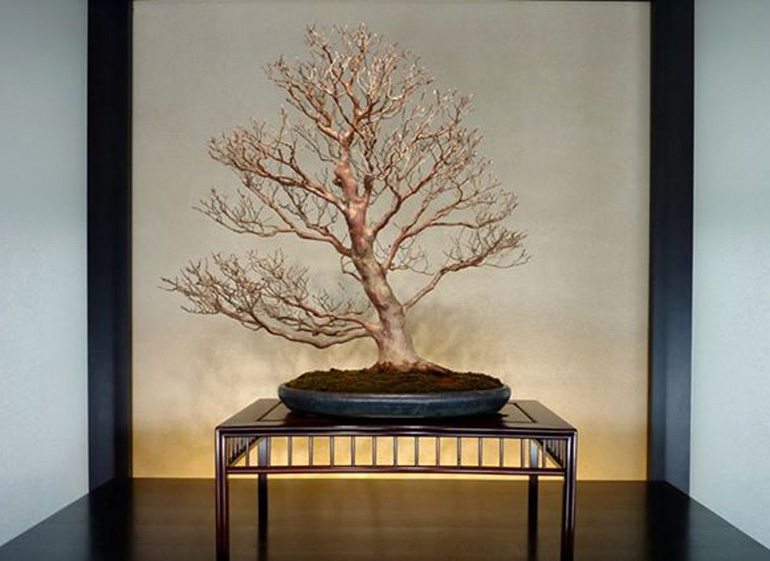
This Stewartia, with its light airy branching, is designed to show off its long smooth trunk and colorful exfoliating bark
In this case it's more about the fruit than ramification. If the birds don't get them, Crabapples can hold their fruit well into the winter

As long as we're talking about ramification... Not to take anything away from this old Trident maple's spectacular trunk.
The delicate branching provides a sharp contrast to the short powerful trunk and its striking nebari. Though Tridents often feature the most developed nebari, this Japanese maple is no slouch in that regard
All the photos in this post were borrowed from the Omiya Bonsai Art Museum’s facebook timeline.
20% OFF EVERYTHING
SITE WIDE SALE
ENDS TOMORROW NIGHT

YOU CAN ENJOY EXTRA DISCOUNTS
IN ADDITION TO OUR SITE WIDE SALE
EXTRA 10% OFF 1-2 ROSHI TOOLS
20% OFF 3 OR MORE ROSHI TOOLS
PLUS AN EXTRA 10% OFF BONSAI POTS
–INCLUDING OUR TIE POTS–
THESE SPECIALS END WEDNESDAY, JAN 23RD AT 11:59PM EST
Another Mid Winter Tease

The new growth on Spruce is often a brilliant yellow. Almost like yellow flowers. In this case the spruce is an Ezo (Picea jezoensis). This one resides at the Omiya Bonsai Art Museum as do the other trees in this post.
Continuing with our long trek home from vacation, I found just enough time to sneak another one in from the Omiya Bonsai Art Museum. Like yesterday it’s also from our archives (June, 2015).
SITE WIDE SALE ENDS SOON
20% OFF EVERYTHING
PLUS AN EXTRA 10% TO 20% OFF ROSHI TOOLS
AN EXTRA 10% OFF BONSAI POTS

For a lot of people, Satsuki azaleas are all about the flowers, so it doesn't matter so much that you can't really see the trunk in this photo. You can however see just how massive it is and that this would be a strong bonsai even without the flowers.
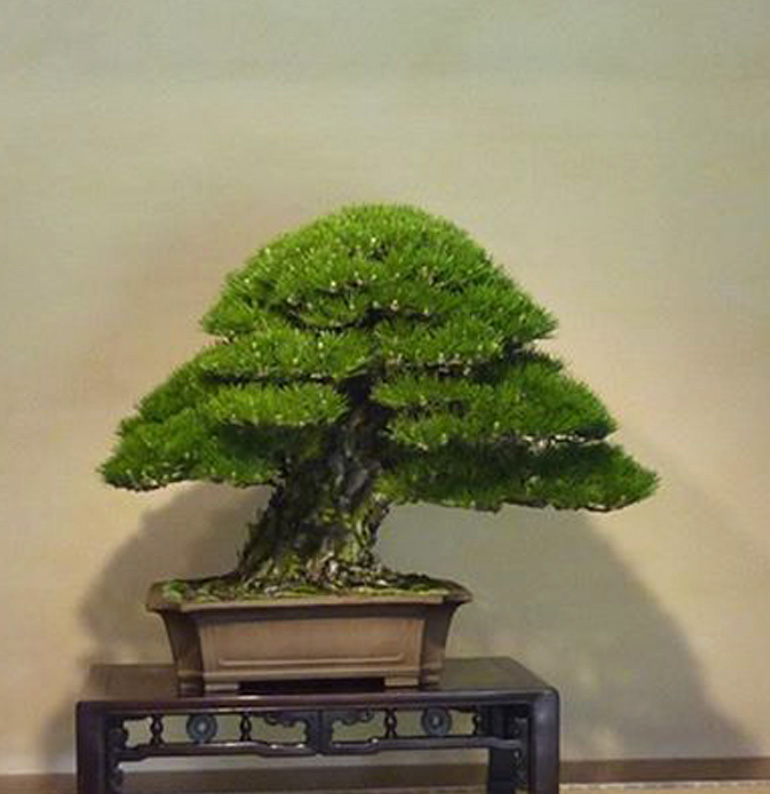
Another massive trunk on an impressive bonsai. It's a Japanese black pine with bright new buds acting as spring accents.
Speaking of Pines…

our masters series Pine Book

Another Satsuki in full flower. So much so that it's okay that the trunk is obscured.

A triple-trunked Trident maple full of fresh yellow-green spring leaves.

Raised-root trunks are not uncommon with Satsuki.
20% off Site Wide Sale
YOU CAN ENJOY EXTRA DISCOUNTS
IN ADDITION TO OUR SITE WIDE SALE
EXTRA 10% OFF 1-2 ROSHI TOOLS
20% OFF 3 OR MORE ROSHI TOOLS
PLUS AN EXTRA 10% OFF BONSAI POTS
–INCLUDING OUR TIE POTS–
FREE Shipping on Continental U.S. orders 75.00+
(only if you chose free shipping when you check out)
STONELANTERN.COM
A Mid Winter Spring Color Tease

Today we begin the long two day journey from sea and sun back to waist high snow and sub zero temps. So no time to put together anything new for you, though this one is old enough (June, 2015) where it will be new to most of you anyway. They are all Azaleas (Satsuki, I think) from the Omiya Bonsai Museum. One of our favorites. Enjoy.
SITE WIDE SALE ENDS SOON
20% OFF EVERYTHING
PLUS AN EXTRA 10% TO 20% OFF ROSHI TOOLS
AN EXTRA 10% OFF BONSAI POTS


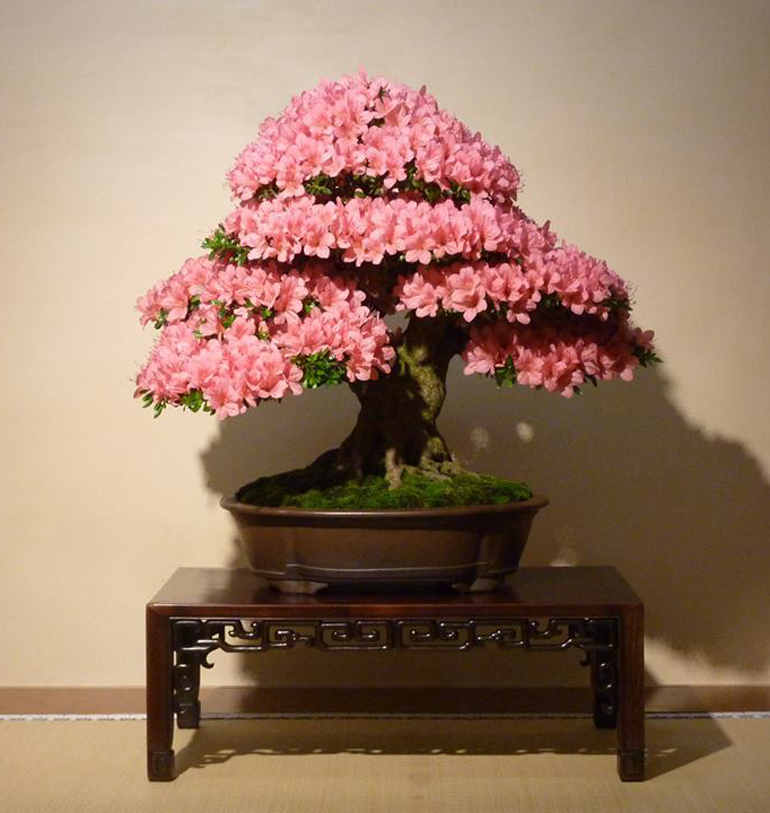

20% off Site Wide Sale
YOU CAN ENJOY EXTRA DISCOUNTS
IN ADDITION TO OUR SITE WIDE SALE
EXTRA 10% OFF 1-2 ROSHI TOOLS
20% OFF 3 OR MORE ROSHI TOOLS
PLUS AN EXTRA 10% OFF BONSAI POTS
–INCLUDING OUR TIE POTS–
FREE Shipping on Continental U.S. orders 75.00+
(only if you chose free shipping when you check out)
STONELANTERN.COM
Exceptional Before & After Bonsai

This has to be one of the most compelling bonsai I've seen in a while. It has that wild, not overly refined look and though the deadwood is prominent, it's not dominated by deadwood like so many trees. But perhaps the best of all are are the brilliant living veins and the way they stand out against the deadwood Island hopping today, so to save precious time, we're going to rerun a post on one of my favorite trees.
This before and after is more about refinement than styling rough stock. Less daunting perhaps, but only someone skilled in the art of bonsai can do what you see here. In this case, that someone is Gabriel Romero Aguade (Bonsai Sant-boi) (this isn’t the first time we’ve featured him on Bark).
Continued below…
Before. Already a very impressive bonsai. Just needs an expert hand to bring out its best
Though no name is mentioned, the tree looks like a Yew. You can tell by the foliage and the reddish bark. Yew bonsai are popping up everywhere. Especially in Europe with the English (aka European) yew (Taxus baccata), where there seems to be an abundance of good stock.
Defoliating Grandfather Bonsai
Here’s Juan Adrade’s English caption for this magnificent old Trident maple. “Partial defolation on one of the grandfather trees. Close to 100 yrs old." Here's his Spanish: "Defoliación de las ramas exteriores en uno de los tridentes del abuelo de mi maestro. Este arbol posiblemente se acerca a los 100 años." You might notice the part about exterior branches in the Spanish. This would indicate that Juan is redirecting energy away from the outer tips and down closer to the center of the tree. This photo is from Juan’s facebook feed.
Defoliation is an important technique for redirecting energy, maintaining balance and creating fine branching. Especially on deciduous bonsai. The photo above is from a post we did in 2014 titled Defoliating Grandfather. The illustrations and text below are from a July 2009 post titled Energy Balancing #6: Defoliation Tips. Most of this post was shown in 2015. I think defoliation warrants the repetition.
MID WINTER SITE WIDE SALE
20% OFF EVERYTHING
PLUS AN EXTRA 10% TO 20% OFF ROSHI TOOLS
AN EXTRA 10% OFF BONSAI POTS
–

Cut…
Use sharp scissors to defoliate. Cut in the center of the petiole (leaf stem). If you cut too close to the base of the leaf stem, you may damage the buds that form there.
…don’t pull
Don’t use you fingers to pinch or pull leaves off. This is a recipe for damage (the unreadable text with the illustration above says: Don’t pull, it could damage the buds). More on defoliation below….

Bonsai Today back issues provide a wealth of information on a wide range of Bonsai topics, including articles on defoliation. All available back issues are now 5.00 each, plus an additional 20% off for our Site Wide Sale.
 Defoliate, then prune
Defoliate, then prune
This illustrations go from right to left, Japanese style. Upper right is before. Lower right is next. It shows after defoliation, but before pruning. The message here is; if you are going to prune and defoliate, then defoliate before you prune so you can better see exactly where to prune (within reason; if you know you are going to remove a whole branch, no point in defoliating it). Bottom center is after pruning (the after pruning tag in the illustration is a little out of place).
Defoliation results in better ramification
The two on the left show what the branch might look like later if you hadn’t defoliated (top) and with defoliation (bottom).
All of the illustrations in this post are by Kyosuke Gun. They originally appeared in Bonsai Today issue #3 (Japanese images courtesy of Bonsai Focus).
20% off Site Wide Sale
PLUS YOU CAN ENJOY EXTRA DISCOUNTS
IN ADDITION TO OUR SITE WIDE SALE
EXTRA 10% OFF 1-2 ROSHI TOOLS
20% OFF 3 OR MORE ROSHI TOOLS
PLUS AN EXTRA 10% OFF BONSAI POTS
–INCLUDING OUR TIE POTS–
FREE Shipping on Continental U.S. orders 75.00+
(only if you chose free shipping when you check out)
STONELANTERN.COM

